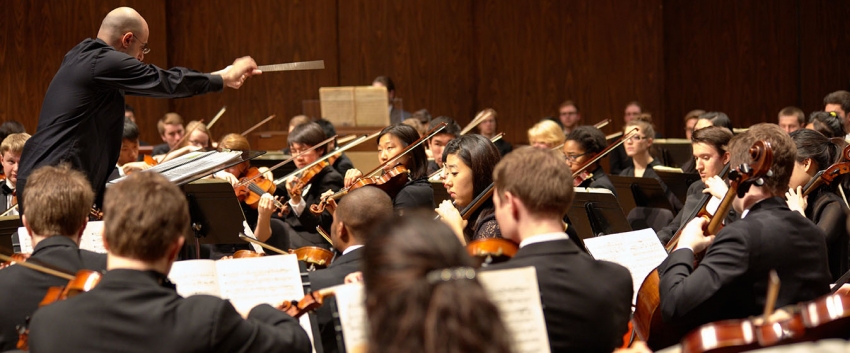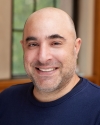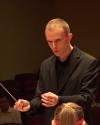David Alexander Rahbee leads the UW Symphony in a program of music by Johannes Brahms and Robert Schumann.
Note: An appearance by Robin McCabe, piano, previously announced for this program, will be rescheduled for a future date.
Program
University of Washington Symphony Orchestra
David Alexander Rahbee, Daren Weissfisch, Ryan Farris, conductors
PROGRAM NOTES
JOHANNES BRAHMS (1833-1897)
Serenade No. 2 in A major, Op. 16 (1859, rev. 1875)
Serenades have traditionally been conceived of as music for easy listening. Why then would Brahms, generally regarded as one of the most serious composers of the romantic era, choose to focus his artistic energy producing not just one, but two works in this genre? The answer is that he used these charming pieces as essentially a kind of experiment in orchestral writing. Even early in his career, Brahms had the goal of composing symphonies and orchestral works on par with the masterpieces of Beethoven, his idol. Being essentially too modest to begin a true symphony in his mid-twenties, Brahms instead produced these two serenades to learn how to compose for the orchestra.
This Serenade No. 2 in A major, originally written in 1859 and then revised 16 years later, has the added curiosity of being scored for an orchestra without violins, brass, or percussion. Throughout the work the woodwinds generally lead the melodic lines, supported by the lower strings, which only occasionally get their turn at having the tune.
The first movement acts much like the opening movement of a symphony would, presenting a series of themes which are subjected to development and expansion in a ‘sonata-allegro’ form. The second movement is a delightful scherzo, featuring playful rhythms passing across the orchestra. The third movement is remarkably somber by comparison, with a brooding, almost Bach-like theme emerging from the lowest strings and weaving its way throughout the movement, which is by far the longest in the work. The fourth movement is a return to a short and playful dance, with a middle section highlighting the low flutes in particular. The finale is a fast and jubilant rondo as one might expect. Here the piccolo finally joins the orchestra to add an extra bit of spritely character to the whole ensemble, rounding off the serenade in high spirits.
ROBERT SCHUMANN (1810-1856)
Symphony No. 2 in C major, Op. 61 (1845-1846)
What we now call the Symphony No. 2 by German composer Robert Schumann was actually the third symphony he had completed. His Symphony in B-flat was published as No. 1 in 1841, but his Symphony in D minor (also composed in 1841, but later revised) was not published for over a decade and now appears as his No. 4. The triumphant tone of this Second Symphony is remarkable considering the state of Schumann’s health when he was writing it. Throughout the years 1845-1846 he suffered from severe depression and ringing in his ears. This in part led him to experiment with composing away from the piano, a shift in compositional strategy which forced him to conceive and work out everything in his head before writing it down.
The symphony begins with a slow brass chorale reminiscent of Haydn’s Symphony No. 104, his final work in that genre. This simple figure will reappear throughout the piece, adding a sense of thematic unity to the entire work. After a long introduction, the first movement launches into a dance-like allegro, at times turbulent but ultimately ending in triumph. As is common in 19th century symphonies the scherzo movement precedes the adagio. This second movement is famous among violinists as it features a seemingly endless cascade of rapid notes played across the entire range of the instrument. The scherzo is interrupted by two different trio sections, the first characterized by spritely triplets passed between winds and strings, and the second enfolding into a beautiful chorale. The scherzo comes to an energetic end with all the violins in unison showcasing rapid scales and arpeggios. The third movement is an elegiac adagio cantabile in C minor, providing a poignant contrast with the virtuosity of the previous scherzo. The finale, ‘Allegro molto vivace’, is a fast and brilliant conclusion, featuring transformations of themes heard in previous movements. During the middle section we hear a lyrical new theme, inspired by a melody from Beethoven’s song cycle An die ferne Geliebte. This gradually unfolds into a brilliant coda, recalling the chorale theme from the opening of the symphony.
-Ryan D. Farris
CONDUCTOR BIOS
David Alexander Rahbee is currently Senior Artist in Residence at the University of Washington School of Music in Seattle, where he is Director of Orchestral Activities and Chair of Orchestral Conducting. He is Music Director and Conductor of the University of Washington Symphony Orchestra and founder of the UW Campus Philharmonia Orchestras. He is a recipient of the American-Austrian Foundation's 2003 Herbert von Karajan Fellowship for Young Conductors, the 2005 International Richard-Wagner-Verband Stipend, a fellowship the Acanthes Centre in Paris (2007), and is first prize winner in conducting from The American Prize national non-profit competitions in the performing arts for 2020. His work at UW has earned national recognition. In 2021 he was praised by The American Prize as “Consistently one of the most courageous and comprehensive [orchestral] programmers working in higher education in the U.S. today…”
Dr. Rahbee has appeared in concert with orchestras such as the Seattle Symphony, RTE National Symphony Orchestra of Ireland, Orchestre Philharmonique du Luxembourg, Kammerphilharmonie Berlin-Brandenburg, Guernsey Symphony Orchestra, Chattanooga Symphony, National Chamber Orchestra of Armenia, Orchestre de la Francophonie, Orchesterakademie der Bochumer Symphoniker, the Dresden Hochschule orchestra, Grand Harmonie, the Boston New Music Initiative, Seattle Modern Orchestra, Orquesta Sinfónica de Loja (Ecuador), Savaria Symphony Orchestra (Hungary), Cool Opera of Norway (members of the Stavanger Symphony), Schönbrunner Schloss Orchester (Vienna), the Whatcom Symphony Orchestra, the Kennett Symphony, and the Divertimento Ensemble of Milan. His collaborations with the Seattle Symphony include assistant conductor for the performance and recording of Ives’ Fourth Symphony, and as guest conductor for their Native Lands project and the North American premiere of Páll Ragnar Pallson's Quake with faculty cellist Sæunn Thorsteinsdóttir. He has collaborated with several prominent soloists such as Sarah Chang, Jon Kimura Parker, Yekwon Sunwoo, Glenn Dicterow and Jonathan Biss. He has been a guest rehearsal conductor for numerous young orchestras, such as the New England Conservatory Symphony Orchestra, The Symphony Orchestra of the Hall-Musco Conservatory of Music at Chapman University, and the Vienna University of Technology orchestra. He has served on faculty of the Pierre Monteux School as Conducting Associate, has been resident conductor of the Atlantic Music Festival and guest conductor at the Hawaii Performing Arts Festival.
Dr. Rahbee was an assistant at the Vienna State opera from 2002-2010. As part of his fellowship and residency at the 2003 Salzburg Festival, Dr. Rahbee was assistant conductor of the International Attergau Institute Orchestra, where he worked with members of the Vienna Philharmonic. He has been selected to actively participate in masterclasses with prominent conductors such as Kurt Masur, Sir Colin Davis, Jorma Panula, Zdeněk Mácal, Peter Eötvös, Zoltán Peskó and Helmut Rilling, and counts Nikolaus Harnoncourt to be among his most influential mentors. From 1997-2001, David Rahbee was founder and conductor of the Fidelio Chamber Orchestra in Cambridge, Massachusetts.
Dr. Rahbeeʼs principal conducting teachers were Charles Bruck and Michael Jinbo at the Pierre Monteux School. He holds a Bachelor of Music degree in violin and composition from Indiana University, a Master of Music degree from the New England Conservatory in orchestral conducting, and a Doctorate of Musical Arts from the University of Montreal in orchestral conducting. He has also participated in post-graduate conducting classes at the Universität für Musik und Darstellende Kunst, Vienna. His brass arrangements are published by Warwick Music, and his articles on the music of Mahler have appeared in journals of the International Gustav Mahler Gesellschaft, among others.
In addition to being awarded first prize in conducting from The American Prize for 2020, he was awarded 2nd place in 2019. He has also placed among winners for five consecutive years for The American Prize Vytautas Marijosius Memorial Award for Orchestral Programming, recognizing his programming with the UW Symphony and its affiliated ensembles for every season since he joined the faculty. The UWSO has also been a finalist in the category of orchestral performance in 2018, 2019 and 2020.
Dr. Rahbee is co-editor of Daniels’ Orchestral Music (6thedition) and Daniels’ Orchestral Music Online (DOMO), the gold standard among conductors, orchestral administrators, orchestra librarians as well as other music professionals and students researching for orchestral programming.
Daren Weissfisch has conducted professional and student ensembles in the United States, Mexico, and Europe for over a decade. He is currently pursuing a doctoral degree in Orchestral Conducting at the University of Washington under the tutelage of Dr. David Alexander Rahbee where he is the conductor of the Campus Philharmonia Orchestras, the assistant conductor of the University of Washington Symphony Orchestra, and conductor of the University of Washington Modern Music Ensemble and Opera Theater Works Orchestra. Daren was recently named House Conductor of the Tacoma Opera and he previously conducted the University of Washington’s opera production of Vinkensport by David T. Little and Joseph Haydn’s opera Philemon und Baucis. Daren has also served as cover conductor for the Harmonia Orchestra Seattle and the Issaquah Philharmonic Orchestra. From 2013 to 2019 Daren was the Artistic Director of the Orquesta Sinfónica Esperanza Azteca Sinaloa, which is an El Sistema based youth orchestra and choir in Culiacán, Sinaloa, Mexico. While in Mexico he was the assistant director for the 2016 production of Charles Gounod’s opera Romeo and Juliet with the Orquesta Sinfónica Sinaloa de las Artes under Sinaloense conductor Enrique Patrón de Rueda and the same year he collaborated with French guitarist Jean Bruno Dautaner to record the guitar concerto Tres en Raya by Spanish composer Antonio Ruíz Pipó under the AdLib MusicMX record label. In 2017 Daren conducted the Sinaloa premier of Horizontes, a work by Mexican composer Samuel Zyman, again with the Orquesta Sinfónica Sinaloa de las Artes, and for the 2017 Sinaloa Cultural Festival Daren founded the ensemble Sinaloa Players which presented Stravinsky’s masterpiece Histoire du Soldat in collaboration with renowned Mexican choreographer Mauricio Nava. Daren was a conducting student of Michael Jinbo at the Pierre Monteux Festival and School for several summers and he also studied with many notable conductors including Ludovic Morlot, Donald Schleicher, Kensho Watanabe, Lior Shambadal, Edward Cumming, Charles Olivieri-Munroe, Gábor Hollerung, Linus Lerner, Carlos Spierer, Sandro Gorli, Glen Adsit and Timothy Salzman among others.
Daren is also an oboist and was the second/assistant principal oboist of the Orquesta Sinfónica Sinaloa de las Artes in Sinaloa, Mexico from 2010-2019 as well as soloist playing oboe concertos by Mozart, Strauss and Bach. He is also a substitute player in the Seattle area with the Bainbridge Island Symphony Orchestra, Harmonia Orchestra Seattle and the Lake Union Civic Orchestra among others.
Ryan D. Farris is an up-and-coming conductor and performer in the Pacific Northwest community. He is currently pursuing his doctorate in Orchestral Conducting at the University of Washington where he is the conductor of the Campus Philharmonia Orchestras and assistant conductor of the University of Washington Symphony Orchestra. Ryan has served as cover conductor for professional orchestras across the country, including the Auburn Symphony in Washington and the Boulder Philharmonic in Colorado. He has also served as an assistant conductor for the Greater Boulder Youth Orchestras and as a sectional conductor for Harmonia Seattle. Ryan was a proud student of the late maestro Michael Jinbo at the Pierre Monteux School and Music Festival in Maine for five summers. He has also studied with many notable conductors including Ludovic Morlot, David Rahbee, Gary Lewis, Nicholas Carthy, Donald Schleicher, Kensho Watanabe, Kirk Trevor, and Tiffany Lu.
Ryan has served as principal cellist with the Boulder Opera Company, Seattle Philharmonic Strings, and the University of Washington Symphony. He has appeared as a featured soloist with the South Pudget Sound College Orchestra, and regularly performs in chamber music groups across the region. Before moving to Seattle, he performed regularly with some of Colorado’s best orchestras, including the Boulder Philharmonic, Fort Collins Symphony, and Colorado MahlerFest. Ryan also performs on viola da gamba with the UW Baroque Ensemble and traditional Irish fiddle and pennywhistle with the acclaimed Seattle-based Celtic group Cavort.



